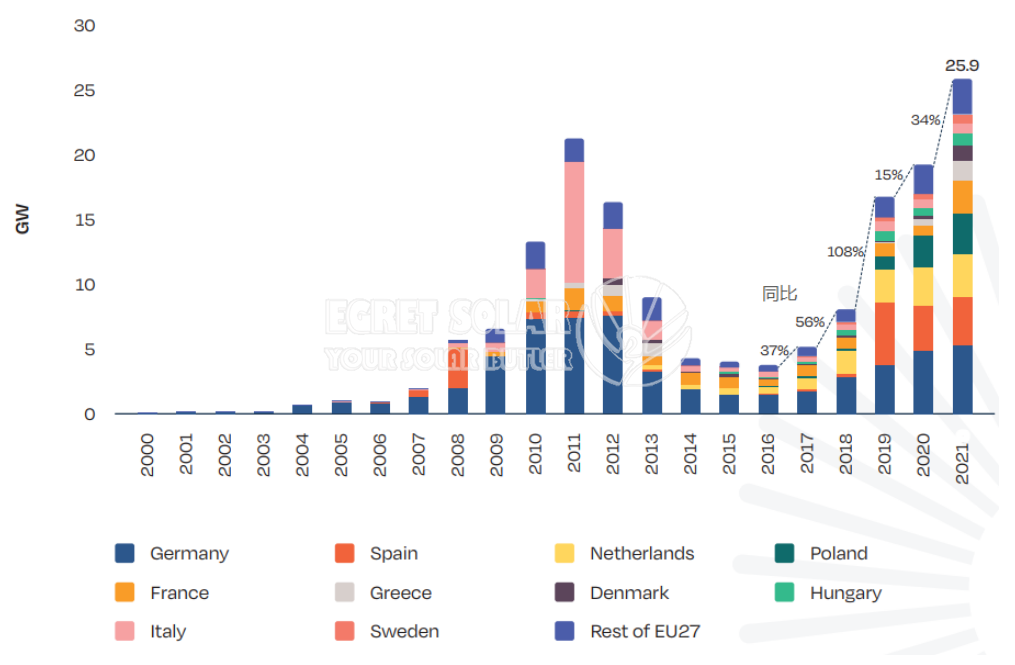- English
- Español
- Português
- русский
- Français
- 日本語
- Deutsch
- tiếng Việt
- Italiano
- Nederlands
- ภาษาไทย
- Polski
- 한국어
- Svenska
- magyar
- Malay
- বাংলা ভাষার
- Dansk
- Suomi
- हिन्दी
- Pilipino
- Türkçe
- Gaeilge
- العربية
- Indonesia
- Norsk
- تمل
- český
- ελληνικά
- український
- Javanese
- فارسی
- தமிழ்
- తెలుగు
- नेपाली
- Burmese
- български
- ລາວ
- Latine
- Қазақша
- Euskal
- Azərbaycan
- Slovenský jazyk
- Македонски
- Lietuvos
- Eesti Keel
- Română
- Slovenski
- मराठी
- Srpski језик
European Photovoltaics Market Development Trend
2024-04-08
This round of accelerated expansion of photovoltaics in Europe is essentially an adjustment in the energy structure triggered by geopolitics. After the Russian-Ukrainian conflict.
The EU is accelerating the process of energy independence and accelerating the decoupling of fossil energy represented by natural gas from Russia. Based on current
Based on practical considerations, the first priority of European countries is to search for natural gas, and the second is to promote national energy independence. On the day of realization.

In the REPowerEU plan for natural gas decoupling, photovoltaic and wind power account for about 20% of the weight.
The core of the expansion of renewable energy, including photovoltaics, lies in fiscal expansion. Although the overall electricity price is relatively high, it is limited by
Regarding lighting resources, current module prices are not enough to enable European photovoltaics to achieve grid parity. Currently distributed in Europe.The industry generally remains at the "FiT" or "net metering" stage, while ground power stations have entered the bidding stage.

And short term to promote the expansion of photovoltaic installed capacity, the policy ideas are: 1) Distributed: or increase the fixed grid-connected electricity price,or expand the scope of "FiT" projects. Compared with the trend before the Russian-Ukrainian conflict, in short, it is more market-oriented take a step back; 2) Ground power stations: increase the bidding volume, relax land use restrictions, or speed up the approval process .
The retreat of marketization means the expansion of fiscal subsidies again. The difference from the previous cycle is that carbon regulation,the introduction of price, the cancellation of EEG surcharges in Germany and investment in carbon credit revenue, and the continued increase of subsidies in Poland.
Its funding sources are all related to carbon credit revenue. The recently accelerated carbon border tax is also part of the fiscal expansion.The rise of photovoltaics in Europe started earlier. According to IRENA data, new installed capacity in Europe reached 2011 23GW, accounting for 74% of global annual new installed capacity. Then it declined year by year. By 2017, European photovoltaic annual new installed capacity is only 6GW, accounting for 6% of global annual new installed capacity.

There are two main reasons for the first round of decline of photovoltaics in Europe:
1) The photovoltaic market boom spurred by high subsidies cannot be sustained during the economic crisis. In the early days, Europe mainly relied on relatively high on-grid electricity prices attracted installations, but during the subsequent European debt crisis, countries were unable to pay higher subsidies. Photovoltaic grid-connected electricity prices have been lowered one after another, causing new installed capacity to plummet;
2) The "double-reverse" policy against China has pushed up component prices and accelerated the shrinkage of the domestic market. The photovoltaic industry chain is feeling the pressure and has imposed anti-dumping and countervailing duties on Chinese manufacturers. But the price of local components in Europe. Higher prices have accelerated the decline in newly installed capacity.
The Installed capacity in EU:

In the new round of recovery, there are three main characteristics:
In the first round of prosperity, Germany, Spain, and Italy were the main players. In the second round of resumption, the main driving force still comes from government subsidies. Limited by lighting resources, most projects in Europe are still unable to achieve parity.
In the Internet and distributed fields, subsidy mechanisms such as "net metering", "net pricing" and "FiT" are the main ones. This explains the delay in Italy's slow economic recovery to start a new round of photovoltaic recovery.




